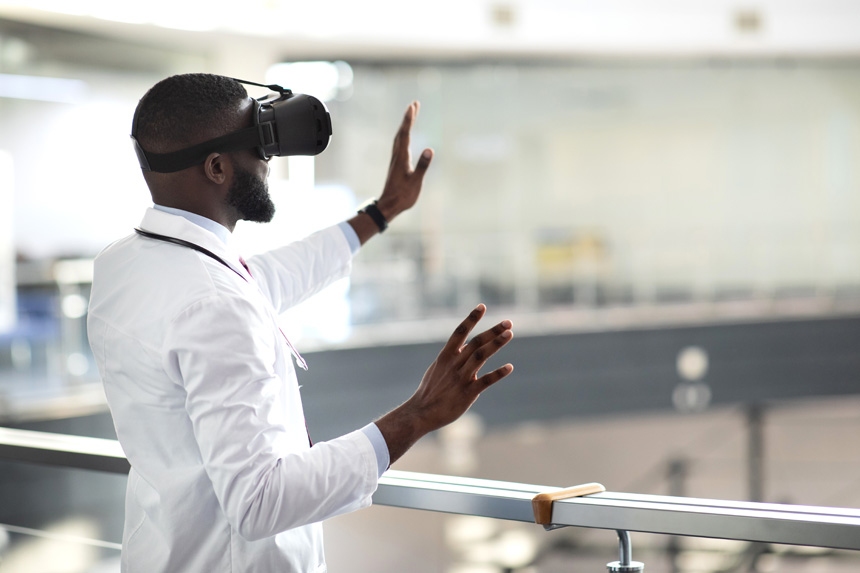In the past decade, the healthcare industry has exploded with innovative technologies that have transformed how health conditions are detected and how patients are monitored and cared for.
Definitive Healthcare President Robert Musslewhite talked about some of the biggest technologies to impact the industry, like telemedicine and precision medicine, in his keynote at Definitive LIVE! In case you missed it, you can watch his full top 10 healthcare trends presentation here or read our four-part blog series that explains and expands upon the trends most likely to impact healthcare in the future.
Today, I want to take a closer look at three other technologies that aren’t receiving quite as much attention as telehealth or genetically personalized care. These emerging healthcare technologies are changing how some patients receive care and interact with their doctors:
- Virtual reality (VR)
- Patient portal technology
- Wearable medical devices
VR transforms the patient and provider experience
When most people think of virtual reality, they probably think of video games and big, clunky headsets. Recently, however, healthcare organizations have started using this technology in a variety of ways to improve patient care and train physicians. And healthcare providers are seeing the benefits.
In fact, a recent Emergen Research study predicts the global augmented reality and virtual reality market will grow from $2 billion in 2020 to a whopping $14.06 billion in 2030.
Specifically, VR is showing great promise in the field of neurosurgery. At Stanford, VR systems are incorporating imaging from CT scans, angiograms, and MRIs into three-dimensional models. These in-depth models help train surgeons to operate more accurately and safely by creating a virtual environment where they can practice each patient’s operation.
VR training can also give residents an up-close, guided, and comprehensive view of the patient. For example, instructors can direct residents through the body, highlighting specific features like bones or tumors. This can help residents gain a realistic experience with the detailed steps involved in a procedure. A Harvard Business Review study found a 230% improvement in participants’ surgical performance when training with a VR platform in advance compared to more traditional methods of training.
Beyond neurosurgery, VR can help patients more effectively manage their pain. VR has been found to be particularly helpful in managing chronic pain and feelings of pain following a procedure. A 2019 study at St. George’s Hospital in the UK found that 80% of patients felt less pain, and 73% of patients experienced less anxiety during wide-awake surgery while wearing a VR headset. While in surgery with the VR technology, patients wore a headset and were immersed in landscapes including hilltops, forests, waterfalls, and beaches around the world.
Physicians can also use VR to educate patients. By showing what’s happening in a patient’s body and how they will be treated, providers can help patients can reach a new level of involvement in and understanding of their care.
Given the opportunities VR presents and its breakthroughs within neuroscience and beyond, we expect it to continue to expand in its utility into the next decade.
Patient portals help patients access information and connect with providers
Patient portals are online platforms that help patients engage with their medical care more directly and communicate with their providers more efficiently. As a type of telehealth, these have become a significant part of healthcare in the last 10 years. These online platforms help patients engage with their medical care more directly and communicate with their providers more efficiently.
According to Definitive Healthcare data, 6,149 of the 7,377 active hospitals that we track (83%) currently have a patient portal system. We also see an overall positive trend in the adoption of patient experience/engagement solutions (patient portals) over a 15-year span.
Adoption of patient portals at U.S. hospitals
Fig. 1 Analysis of patient experience/engagement solution technology implementation is from the Definitive Healthcare HospitalView product. Data accurate as of August 2023.
Patient portals are also expected to grow at a CAGR of 15.6% to reach a $7,646.6 million market size by 2027.
Patient portals may come bundled with an EHR/EMR system or offer a tool to integrate a healthcare provider’s system into the patient portal. When used together, these technologies can offer a host of benefits, including:
- Decreased medical errors
- Improved office efficiency
- Streamlined workflow
- More patient-centric care
- Enhanced patient engagement
- Greater convenience
Despite the high adoption of patient portals among healthcare organizations, only about 40% of patients in the U.S. accessed a patient portal in 2020. This relatively low adoption rate could be indicative of more widespread disparities in health.
A study found that people who didn’t use patient portals were more likely to have less than a college education, be on Medicaid, be male, and lack a regular medical provider compared to portal users. The study also found that patients of color were less likely to be offered access to the portal. Low usage of patient portals may also be attributed to accessibility, as these platforms require an internet connection.
While 40% adoption is perhaps a bit lower than ideal, this number was up 13 percentage points from 2014, which shows the technology does continue to rise, albeit slowly. Going forward, providers can help play a role in ensuring their patients know about the portal, have access to it, and understand how to navigate it.
Wearable medical devices give patients control over their health
Do you wear a fitness tracker like nearly 25% of the population? If so, you’ve likely experienced the benefits of wearable technology first-hand. While many of these devices are considered primarily recreational, they’ve shown usefulness in the support of patient care.
The value of wearables doubled from $325 million to $722 million between 2016 and 2019. And the market is predicted to grow even more to an astounding $31.95 billion in 2026.
Among the more visible emerging healthcare technologies, wearable health and medical devices can give more power to individuals over their health. In particular, health and fitness devices offer individuals valuable health data like oxygen saturation, sleep levels, and heart rate. People can then use this data to make positive lifestyle choices about how they eat, sleep, exercise, and more.
These kinds of health data can potentially save lives. In some situations, smartwatches can alert the user to developing emergencies and give them time to seek medical attention. In the case of one 34-year-old Fitbit user, the device alerted him to an abnormally low heart rate that was later found by medical professionals to be caused by coronary artery blockages, saving his life.
Many wearable devices are also compatible with mHealth technology, such as mobile apps. Interestingly, Definitive Healthcare data shows that 2,080 of the 7,377 hospitals we track (28%) have implemented mobile technology, or an app, which may reflect the increasing role mobile apps will play in healthcare and medicine.
In addition to health and fitness devices, there is a wide variety of FDA-approved medical devices, including wearable biosensors, ECG monitors, and blood pressure monitors, many of which launched in the past five years. These devices tend to be cleared by the FDA due to their specialized nature in diagnosing and treating various conditions and diseases.
As care continues to shift into the digital space, we predict wearable medical devices will become increasingly important in providing high-quality and accessible medical care beyond the inpatient and office settings.
Learn more
As healthcare continues to rapidly innovate, our healthcare commercial intelligence can give you the most accurate, current insights to help you stay in tune with new industry and medical technology developments.
To explore more about how you can utilize Definitive Healthcare’s intelligence to create new paths to commercial success, start a free trial.
Updated August 16, 2023






